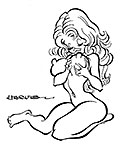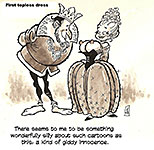NIPPLES,
BARED AND EXPOSED
—ANY
RIOTING IN THE STREETS YET?
A Hitherto
Suppressed Essay on Booby Fruit
ONE OF THE
THINGS about at least one of the annual comic-cons that never fails to amuse me
is the management's attitude about nipples.  And not all nipples; just those on female
chests. Ostensibly, the management is opposed to displays of
"nudity." But actually, "nudity" is not the object of the
crusade. In fact, nudity is permissible under certain conditions. Humans
depicted from the rear, for instance, can be completely naked. But neither
male nor female genitals can be displayed. Ditto female nipples. (Male
nipples are okay.) And not all nipples; just those on female
chests. Ostensibly, the management is opposed to displays of
"nudity." But actually, "nudity" is not the object of the
crusade. In fact, nudity is permissible under certain conditions. Humans
depicted from the rear, for instance, can be completely naked. But neither
male nor female genitals can be displayed. Ditto female nipples. (Male
nipples are okay.)
Such
nudities as are prohibited must be "masked" or in some fashion hidden
from view. As a result of this policy, works of art in which nude females
appear are deliberately defaced by those displaying them. Little snippets of
masking tape are stuck onto the nipples, covering them up.  It's as if the sight of a
woman's nipple alone is enough to incite otherwise civilized males to rapine
and other ravishments. (With a little imagination, of course, it's possible to
envision a nipple where the masking tape is; but let's not be logical, shall
we? And who was it who said "concealing is sexier than revealing"?
Jean Harlow? George Burns? Voltaire? Randolph Scott? That's right: everyone—everyone
knows it.) It's as if the sight of a
woman's nipple alone is enough to incite otherwise civilized males to rapine
and other ravishments. (With a little imagination, of course, it's possible to
envision a nipple where the masking tape is; but let's not be logical, shall
we? And who was it who said "concealing is sexier than revealing"?
Jean Harlow? George Burns? Voltaire? Randolph Scott? That's right: everyone—everyone
knows it.)
We
all realize the reason for such policies as this. It’s to protect the
children. A laudable reason, surely. Children must be protected. Children
come to comic book conventions, and they walk around looking at everything.
And if we didn’t mask nipples, children would see them and—and what? Run riot
in the streets?
Don’t
children have mothers of the female persuasion? Well, yes, runs the reasoning:
but they don’t know what nipples are for, and until they’re old enough to know,
we need to prevent the matter from coming up.
Does
this make sense to you? What are nipples for anyhow? Don’t children know? If
they don’t, how did they spend their infancy?
Well,
bottle babies don’t know. And we have to protect bottle babies ...
Geez,
gang.
You
can tell that I regard the so-called logic of this policy as hilarious. So it
should come as no surprise that I found a newsstory about a trial in Lafayette,
Louisiana, entertaining as well as educational. A local ordinance applying to
"gentlemen's clubs" employs the same logic as some comicon managers:
nude female dancers, the law stipulates, cannot bare their nipples.
In
1993, a raid on one of the establishments where nude women regularly cavort
produced the arrest of seven of the cavorters who were "dancing with their
nipples exposed." This was not a trivial matter: in Lafayette where they
take nipples as seriously as they do at comicons, exposing them is a felony
that could result in a prison term.
The
defense lawyer, however, initiated a supremely satirical strategy. He had the
dancers tell the truth. And the truth, apparently, is that the dancers had
found a way around the law.
The
relevant statute, while specifying that nipples must be covered up, does not
say what the covering should be. The dancers explained that they had, indeed,
complied with the letter of the law: they covered their nipples by painting on
a layer of latex, which they allowed to dry and then applied foundation, powder
and a blush makeup to make the latex shield resemble a nipple.
No,
I'm not making this up.
To
assist the jury in comprehending the effects of this maneuver, the defense
lawyer presented several of the dancers in their prescribed, er, costume.
After eyeballing the real thing—or, rather, the fake—the jury found all the
women innocent.
And
so once again, the appearance is more persuasive than the reality.
Life
is just full of such lessons as this.
Of
course, at comic-cons we've known this for years: it is the appearance that is
being censored, after all—not to mention the reality.
But
that brings us to an extremely relevant question—:
If Nude
Is Art, Why Is Naked Porn?
“In
Picasso’s work, everything is staked on sensation and desire. His aim was not
to argue coherence but to go for the strongest level of feeling. ... The most
powerful element in the story was sex. The female nude was his obsessive
subject. Everything in his pictorial universe, especially after 1920, seemed
related to the naked bodies of women. Picasso imposed on them a load of
feeling, ranging from dreamy eroticism (as in some of his paintings of his
mistress Marie-Therese Walter in the ‘30s) to a sardonic but frenzied
hostility, that no Western artist had made them carry before. He did this
through metamorphosis, recomposing the body as the shape of his fantasies of
possession and of his sexual terrors. Now the hidden and comparatively
decorous puns of Cubism (the sound holes of a mandolin, for instance, becoming
the mask of Pierrot) came out of their closet. ‘To displace,’ as Picassco so
described the process, ‘to put eyes between the legs, or sex organs on the
face. To contradict. Nature does many things the way I do, but she hides
them! My painting is a series of cock-and-bull stories.’”
—Robert
Hughes
AND HERE IS
CRITIC Susan Sontag on “the pornographic imagination”: Pornography’s aim, she
says, is to induce sexual excitement. (And wasn’t Picasso’s aim somewhat the
same?) The pornographer includes nothing in his or her work that does not contribute
directly to the erotic stimulation that is his or her purpose. But this
“purported aim or effect,” Sontag writes, is not a “defect.” Other kinds of
literature aim with similar obsessiveness to excite the reader or observer.
Pornography’s “celebrated intention of sexually stimulating readers is really a
species of proselytizing. Pornography that is serious literature aims to
‘excite’ in the same way that books which render an extreme form of religious
experience aim to ‘convert.’”
The
problem with pornography is a social one, not an artistic one. Says Sontag:
“There still remains a sizable minority of people who object to or are repelled
by pornography not because they think it’s dirty but because they know that
pornography can be a crutch for the psychologically deformed and a
brutalization of the morally innocent.” Thus, their objection to pornography
is rooted in fear--very possibly, fear of seeing in pornographic works a secret
repressed version of their own psyche, something they’ve been persuaded is
unwholesome in their own natures. Attacking pornography perpetuates that
repression.
What’s
really at issue in the availability of pornography, Sontag writes, is “a
concern about the uses of knowledge itself. There’s a sense in which all knowledge
is dangerous, the reason being that not everyone is in the same condition as
knowers or potential knowers.” It may be, she says, that certain kinds of
knowledge are bad for certain kinds of people--particularly those whose life
experiences have not properly prepared them for this new knowledge, whatever it
may be.
And
so we come back to the children again. What should they know? And when should
they know it?
The
problem with pornography is not that it is often lousy art or atrocious
writing. If it’s bad,  it’s because genuinely talented artists and writers have
been persuaded not to try their hands at this dirty stuff. No, the problem is
that pornography is about sex. And so are female nipples. To adults, female
nipples suggest sexual activity, not dinnertime. And we aren’t prepared, yet,
to let children have much knowledge about sex. They’re not ready. They may
be, in Freud’s phrase, “polymorphously perverse” in some sexual sense, but they
aren’t yet emotionally equipped to enjoy sex the way adults do. So we want to
keep it a secret just a little longer. Like the fiction of Santa Claus. What
harm can that do? it’s because genuinely talented artists and writers have
been persuaded not to try their hands at this dirty stuff. No, the problem is
that pornography is about sex. And so are female nipples. To adults, female
nipples suggest sexual activity, not dinnertime. And we aren’t prepared, yet,
to let children have much knowledge about sex. They’re not ready. They may
be, in Freud’s phrase, “polymorphously perverse” in some sexual sense, but they
aren’t yet emotionally equipped to enjoy sex the way adults do. So we want to
keep it a secret just a little longer. Like the fiction of Santa Claus. What
harm can that do?
THE ARTIST,
like Picasso, must express himself. Why can’t cartoonists do the same? Nekkid
wimmin in cartoons represent just another manifestation of the artistic motive:
the same passion that drove Rubens to paint naked women moves a cartoonist to
do the same. For the visual artist, the impulse to explore his human
surroundings and to convert his impressions to overtly conscious understanding
of the world is the motive.
The
graphic artist draws or paints in order to “visualize” the world around him.
The visualization involves a creative act that organizes the riot of color and
form that he sees before him. We all try to organize the confusion of our
sensing of the world around us. Language is the most conspicuous evidence of
this impulse: merely by stringing words together in a meaningful sentence, we
bring stasis to flux, order to chaos, organization to confusion.
“Organization”
is a species of “interpretation,” and the artist’s effort is to interpret the
world he sees for himself, essentially for his own psychic benefit.
Incidentally, other witnesses to the work may grasp and agree with the
interpretation.
Drawing
women in the nude for a male artist is clearly an interpretive exercise of
sexual fantasy. The interpretation involves erotic imagination as well as
purely artistic motives. The existence of two sexes will do that. That’s
nature taking one of the courses open to it.
The
cartoonist or comic book artist, as a species of graphic artist, draws nekkid
wimmin for precisely the same reasons.  And when his effort results in pictures that are
vaguely humorous (or even uproariously comedic), that merely reflects the
lunatic interpretation a comedian is likely to make of any aspect of the human
condition. The impulses being indulged, however, are the same for the
cartoonist as for the Grand Masters. And when his effort results in pictures that are
vaguely humorous (or even uproariously comedic), that merely reflects the
lunatic interpretation a comedian is likely to make of any aspect of the human
condition. The impulses being indulged, however, are the same for the
cartoonist as for the Grand Masters. 
Cartoonists
and comic book artists should have the same rights asRubens. Their works
should be permitted to hang in public places. Likemuseums. Like
exhibitions. Like conventions, even comic book conventions.
And
children should be taught by their parents about how to view such works. Parents who
are timid about sex or reluctant to talk about it should not be permitted to
foist off on to the rest of civilization their timidities, turning us all into
agents of repression. That way lies madness (as you may have noticed).
Return to Harv's Hindsights |